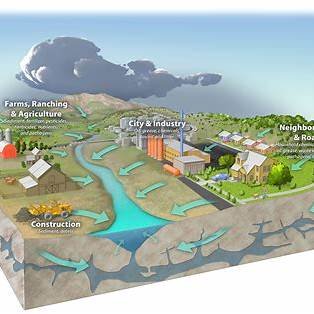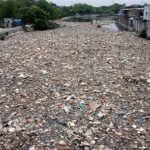Pros of Nonpoint Source Pollution:
Scientists consider Nonpoint Source pollution to be a damaging environmental problem with strong scientific merit. Water contamination along with habitat destruction and biodiversity loss result from this pollutant type. The analysis of NPS pollution shows that this form differs from single-source pollution because it originates from various broad areas including agricultural fields and urban streets and forests and other land areas. NPS pollution may occur due to human actions which deliver substantial societal advantages as well as economic growth and national development. This article studies how the positive effects produced by human activities that produce nonpoint source pollution create indirect advantages through indirect analysis.

What is Nonpoint Source Pollution
Nonpoint source pollution consists of environmental contaminants that originate from various unidentified areas which end up in the natural environment through rainfall and snowmelt as well as irrigation channels. Common pollutants include:
Fertilizers and pesticides
The combination of oil products with grease substances and dangerous chemicals can be found in urban runoff.
Sediment from construction or deforestation
Pathogens from livestock or septic systems
NPS pollution poses management challenges since it stems from many different sources while point source pollution emerges from one clear origin.
This section introduces an analysis of NPS pollution through comprehensive investigation.
Although nonpoint source pollution proves harmful to the environment the underlying activities responsible for it produce many important advantages. Environmental regulations benefit from strategic assessments of human development together with biodiversity protection.
Enhanced Agricultural Productivity
- The implementation of fertilizers and pesticides by agricultural operations generates substantial NPS pollution. However, these chemicals also:
- Higher food output emerges from agriculture thanks to this method.
- The application of protective measures shields agricultural produce from disease outbreaks along with pest infestations.
- The establishment of food security at sufficient levels matches population growth.
- The development of modern agricultural systems has allowed billions of people to be fed through chemical-based methods which primarily contributed to this achievement.
Economic Growth Through Urbanization
- Habitat construction makes more areas resistant to rainfall with its concrete features and this results in contaminated water flowing into local reservoirs. Still, urban growth also:
- Drives economic expansion and job creation
- Improves housing, infrastructure, and services
- The accessibility to healthcare services as well as educational institutions and technological networks improves through the process.
- The economic activity generated by cities functions as their main driving force although these activities contribute to NPS pollution yet they simultaneously raise the quality of life for thousands of residents.
Infrastructure Development and Transportation
Sedimentary materials and chemical substances flow out of construction sites during activities thus contaminating surrounding waterways. Yet, they also:
These infrastructure facilities are essential for creating necessary roads and bridges as well as hospitals and schools.
Improve public transportation and logistics
Facilitate trade and mobility
The importance of developing infrastructure outweighs other considerations even when environmental requirements need to be integrated effectively.
Energy Production and Industrial Growth
The pollution of NPS results from power plants and industrial zones as well as mining operations through atmospheric pollution combined with runoff processes. However, these sectors:
- Housing sectors together with industrial enterprises receive their energy supplies from these sources while transportation systems are powered by them also.
- Generate employment and boost GDP
- Support technological innovation and manufacturing
- Modern economic systems depend on current energy systems because a smooth transition to clean energy is already underway.
Forestry and Logging Operations
- The process of changing land use and forest clearance releases sediment and nutrients to streams however forestry activities simultaneously do:
- Forest management supplies raw materials for home building while yielding both solid fuel materials and pulp products.
- Rural economic systems gain support through these activities while delivering employment opportunities.
- Tree-related operations generate export revenues in addition to trade revenue.
- Sustainable forestry management methods reduce NPS pollution without compromising the valuable benefits of these operations.
Recreational and Tourism Development
These facilities alongside golf courses and resorts utilize fertilizers alongside pesticides which elevate the likelihood of runoff from happening. However, these venues:
- The development of local tourism together with hospitality operations will create additional income within the community.
- Create seasonal and long-term employment
- Encourage outdoor recreation and wellness
- Green landscaping and eco-tourism establish options that help people benefit from these advantages with reduced environmental consequences.
The challenge lies in managing pollution by finding ways to prevent progress from stopping.
Knowledge of how NPS-supporting operations benefit the environment should not minimize their environmental impact. Integration of solutions represents the answer to resolve current environmental challenges.
Enforcing Best Management Practices (BMPs) employs buffer zones and contour plowing as well as permeable pavements to decrease runoff from agriculture and cities.
Public Education programs must provide citizens with complete knowledge about how their regular behaviors affect water quality.
Regulatory bodies should create better policies which support sustainable methods while permitting economic growth to remain unaffected.
Conclusion
Nonpoint pollution continues to deteriorate conditions in the environment yet stems primarily from practices that provide essential social value. Each social activity of agriculture combined with urbanization and energy development and tourism serves a genuine societal purpose. The identification of advantageous aspects from fundamental activities enables us to establish better environmental protection strategies which reinforce ongoing social development. The path to success depends on developing new solutions and eco-friendly methods and showing readiness to create equilibrium between economic goals and ecological needs for mutual benefits between society and nature.








